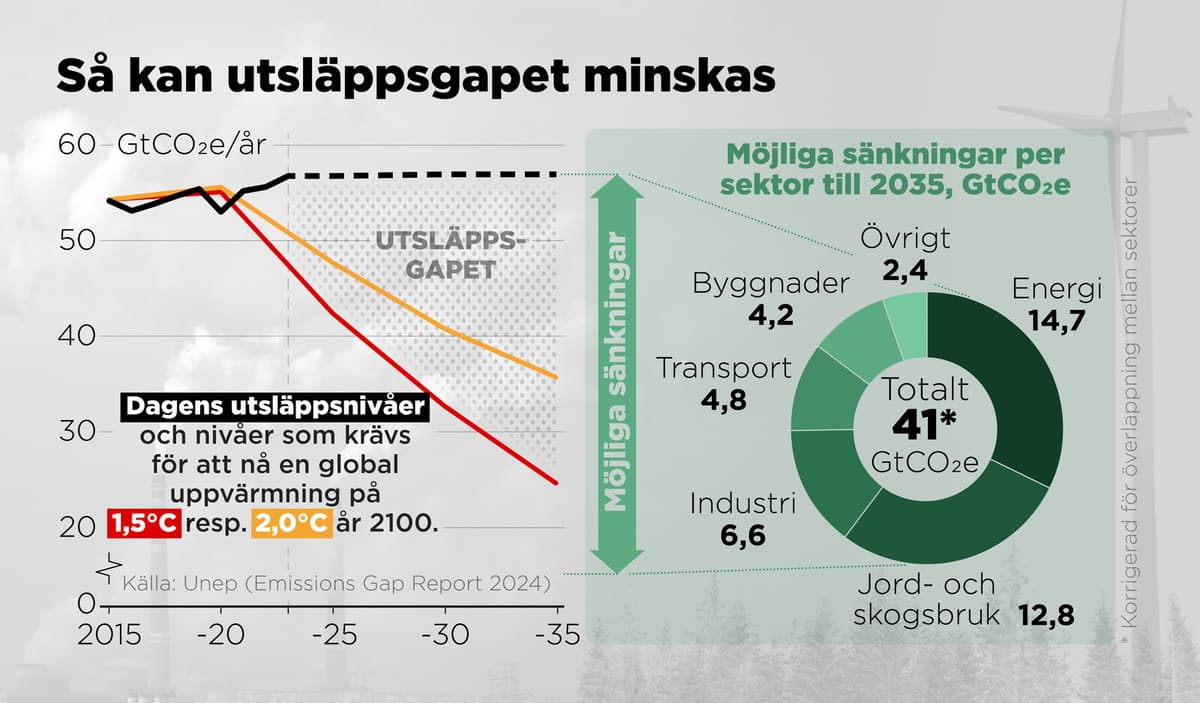The UN's environmental organization Unep notes that 2023 became another record year for greenhouse gas emissions, while climate change becomes increasingly evident worldwide, with heatwaves, droughts, and floods.
Some parts of the world are burning, and some are drowning. And people everywhere are struggling to cope and, in many cases, to survive, especially – as always – among the poor and most vulnerable, says Unep chief Inger Andersen at a press conference.
But the peak may have been reached. 2024 could mark the beginning of a decline if the EU's emission reduction continues and the development of fossil-free energy sources in China and India exceeds demand.
But you need to see a peak and then a continued decline over several years before you can say: okay, that was a peak, says Anne Olhoff, research chief for the report, to TT.
Far from the goal
The report looks at actual emissions and what the world's different countries have promised to do by 2030 and 2035. If we continue as we are, global temperature increase is expected to reach 3.1 degrees this century. If all countries keep their promises, the increase will be 2.8 degrees, and if poor countries receive financial support for costly investments, the increase will be 2.6 degrees.
If countries that have promised zero emissions in the future succeed, the increase will be 1.9 degrees.
In three out of four scenarios, we are thus far from the Paris Agreement's goal of keeping global warming below 2 degrees, preferably 1.5 degrees.
It requires a rapid and massive increase in emission reductions, according to Unep.
We would need the global emission levels to fall below the most stringent of the current climate targets for 2030, otherwise, we have no chance of limiting global warming to 1.5 degrees, and it will also become very difficult to reach below 2 degrees, says Olhoff.
Reductions possible
But Unep notes that it is still possible to make drastic emission reductions to stay around the 1.5-degree target, if all countries – especially G20 countries – increase their pace. Two of the most effective measures are to accelerate the expansion of solar and wind power, which can eliminate a quarter of the reductions needed by 2030.
An additional fifth of the gap can be closed through reduced deforestation and reforestation. Unep also highlights energy efficiency, electrification, and changing fuels in buildings, transportation, and industry.
It shows that we have many opportunities to actually reduce emissions and accelerate the reduction of emissions here and now, says Olhoff.
It can feel hopeless to follow the emissions, which continue to increase year after year, she admits.
I think we all feel that. But on the other hand, I think we see progress. They are just so slow.
This is something that takes time, but the problem is that we are running out of time.
Gustav Sjöholm/TT
Facts: Investigating differences
TT
Research report "Emissions Gap Report 2024" from the UN's environmental organization Unep investigates the difference between the emission reductions that countries have committed to and the emission reductions required to limit global warming to 1.5°C or 2°C.
This is the 15th time Unep releases the report, which takes place ahead of the UN Climate Conference COP29, held in Baku, Azerbaijan, between November 11 and 22.
Global greenhouse gas emissions reached a record high of 57.1 gigatons of CO2 equivalents in 2023, an increase of 1.3 percent (0.7 gigatons).
+ The expansion of renewable energy sources is accelerating rapidly. 700 gigawatts can be added this year, more than double the amount in 2022.
+ Countries such as Greece, the UK, Denmark, Spain, and Portugal have significantly reduced the share of coal in their electricity production.
+ Electric car sales in Norway, Iceland, Sweden, Finland, Belgium, and China have increased.
+ China has rapidly expanded its renewable energy, and preliminary figures indicate that the country has for the first time since the pandemic measured a decline in CO2 emissions for a quarter.
+ The USA, the world's second-largest emitter, reduced its total greenhouse gas emissions by 1.4 percent in 2023 compared to the previous year.





